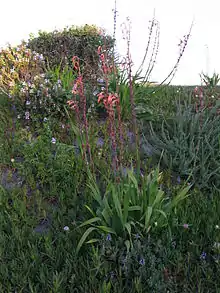Vivipary
In plants, vivipary occurs when seeds or embryos begin to develop before they detach from the parent. Plants such as some Iridaceae and Agavoideae grow cormlets in the axils of their inflorescences. These fall and in favourable circumstances they have effectively a whole season's start over fallen seeds. Similarly, some Crassulaceae, such as Bryophyllum, develop and drop plantlets from notches in their leaves, ready to grow. Such production of embryos from somatic tissues is asexual vegetative reproduction that amounts to cloning.

.jpg.webp)
Description
In some species of mangroves, for instance, the seed germinates and grows from its own resources while still attached to its parent. Seedlings of some species are dispersed by currents if they drop into the water, but others develop a heavy, straight taproot that commonly penetrates mud when the seedling drops, thereby effectively planting the seedling. This contrasts with the examples of vegetative reproduction mentioned above, in that the mangrove plantlets are true seedlings produced by sexual reproduction.
In some trees, like jackfruit, some citrus, and avocado, the seeds can be found already germinated while the fruit goes overripe; strictly speaking this condition cannot be described as vivipary, but the moist and humid conditions provided by the fruit mimic a wet soil that encourages germination. However, the seeds also can germinate under moist soil.[1]
Reproduction
Vivipary includes reproduction via embryos, such as shoots or bulbils, as opposed to germinating externally from a dropped, dormant seed, as is usual in plants;[2][3]
References
- "UCLA: The Mildred E. Mathias Botanical Garden". ucla.edu.
- Kenneth, John H. Henderson's Dictionary of Scientific Terms. Oliver and Boyd 1960 ASIN: B000HG6JE8
- Jackson, Benjamin, Daydon; A Glossary of Botanic Terms with their Derivation and Accent; Published by Gerald Duckworth & Co. London, 4th ed 1928